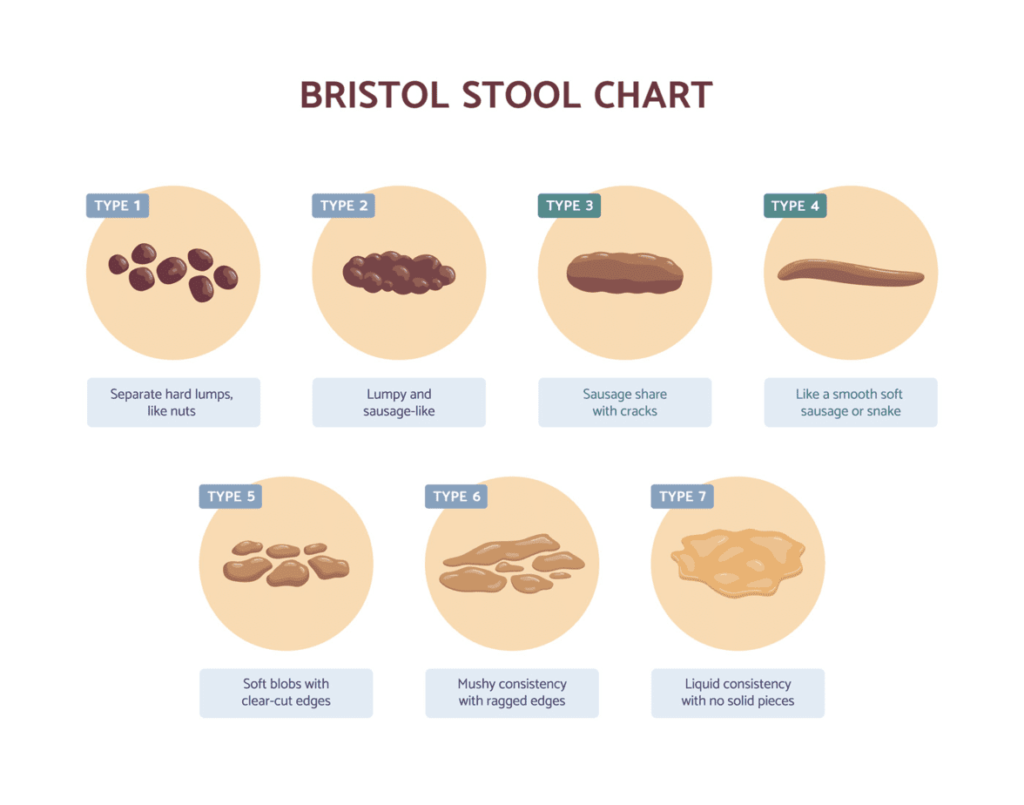What Your Poop Says About Your Health

We all do it; and while it may not be some people’s favorite talking topic, poop can tell us a lot about your health. It can come in many different shapes, sizes, colors and smells; but what exactly indicates a healthy (or unhealthy) poop?
What is healthy poop?
- Stool (or poop) is made up of 75% water and 25% solid matter which consists of bacteria, indigestible food and inorganic substances. It’s important to note that even healthy stool can still have a wide variety, sometimes it can even vary day to day.
- Size, shape, color
- A normal healthy stool should be somewhat log-like in shape and 4-8 inches in length. Any shade of brown coloring is healthy! The combination of stomach bile and bilirubin helps give stool it’s brown shade.
- Timing & frequency
- Healthcare providers agree that healthy bowel movement frequency can range from three times a day to three times a week. Most people tend to have bowel movements in the morning. Once the body has digested your food overnight, it’s normal to have to go first thing in the morning. It’s also normal, however, to have bowel movements at other times of the day.
- Most importantly no matter the time of the day, it should only take a couple of minutes to have a successful bowel movement. If it takes longer than 10-15 minutes or if there is pain or straining, this could be a sign of constipation or pelvic floor dysfunction!
- Size, shape, color

If you have concerns about your bowel health, it may be helpful to know what type of stool you most commonly have before you see your healthcare provider. The Bristol stool chart is a diagnostic tool used to help classify stool into seven different categories:
- Type 1
- Shape & consistency: small round pellets, usually difficult to pass
- What it means: You could be constipated. Constipation can be caused by diet, lack of exercise or pelvic floor dysfunction. It’s ok if that happens every once in a while but consistent type 1 stool could be a reason to see your healthcare provider.
- Type 2
- Shape & consistency: log-shaped but lumpy
- What it means: Usually still indicates some level of constipation, again should not happen frequently.
- Type 3
- Shape & consistency: log-shaped with a few cracks on the surface
- What it means: Type 3 is considered the gold standard of poop! It can indicate your digestive system is working the way it should, this should be soft and easy to pass.
- Type 4
- Shape & consistency: smooth and snake-like
- What it means: This is also normal!
- Type 5
- Shape & consistency: soft blobs with defined edges
- What it means: Similar in shape to type 1 but easier to pass, this could indicate a lack of fiber in your diet
- Type 6
- Shape & consistency: mushy blobs with ragged edges
- What it means: Mild diarrhea, this could be related to diet, illness or a medical condition. If you have chronic diarrhea it could mean your digestive system is not absorbing the proper nutrients it needs.
- Type 7
- Shape & consistency: completely watery with no solid pieces
- What it means: Diarrhea, this means your stool moved through your bowel too quickly and did not form into a healthy poop. This can happen due to illness, food poisoning or even food intolerances. If this happens regularly, consider speaking with your healthcare provider.
How can Pelvic PT help?
- A pelvic floor physical therapist will perform a comprehensive evaluation looking at posture, strength, flexibility, neuromuscular control and muscle imbalances. Your physical therapist can help educate you on:
- understanding the mechanics of defecation
- learning proper toileting posture
- bringing awareness to your pelvic floor
- teaching you the correct breathing and relaxation techniques, so that you can be a happy pooper!
We are here to help!
- Body Harmony Physical Therapy offers one pelvic health physical therapist to one patient evaluation and treatment sessions. Our treatments are for up to one hour in a private treatment room (not a booth). We provide individualized home programs to every patient. We offer a quick call back option for potential patients who have questions or concerns related to physical therapy.
Resources:
- Chumpitazi BP, Self MM, Czyzewski DI, Cejka S, Swank PR, Shulman RJ. Bristol Stool Form Scale reliability and agreement decreases when determining Rome III stool form designations. Neurogastroenterol Motil. 2016 Mar;28(3):443-8. doi: 10.1111/nmo.12738. Epub 2015 Dec 21. PMID: 26690980; PMCID: PMC4760857.
- https://health.clevelandclinic.org/healthy-poop-shape-type-color/
- https://www.healthline.com/health/digestive-health/types-of-poop#what-does-healthy-poop-look-like
- https://my.clevelandclinic.org/health/diseases/17791-frequent-bowel-movements







